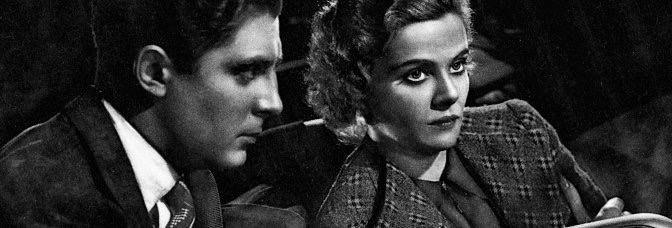Young and Innocent is about Nova Pilbeam (Young) and Derrick De Marney (Innocent). She’s a county police constable’s daughter, he’s an escaped murder suspect. They first meet during his interrogation, when he faints at discovering he’s not just accused of murdering a woman, but that woman has also left him some money. Pilbeam nurses De Marney back to consciousness, rather amusingly. Young and Innocent occasionally has some humor; it pops up irregularly.
Pilbeam’s age is never mentioned–she was seventeen at the time of filming (De Marney was thirty-one), but she’s old enough to have her own car and take care of her five little brothers. She comes off as a lot more thoughtful and aware than De Marney, who’s extremely impulsive. But the Young part of the title doesn’t matter anywhere near as much as the Innocent part. Once on the run, De Marney comes across Pilbeam and convinces her to help him for a while. Then a while longer. Then she’s finally all in.
The film runs a mostly speedy eighty minutes; Pilbeam and De Marney need to go various places to figure out how to prove his innocence. Considering how he gets railroaded by Scotland Yard and, presumably, Pilbeam’s dad (Percy Marmont), it seems unlikely De Marney’s scheme would actually result in the police clearing him. They go all over the English countryside around the small, costal town where the murder’s committed, eventually all the way to the big city in their pursuit of evidence.
The first act, after setting up the murder–the audience knows De Marney is in the clear from the start–and then De Marney’s escape, is Pilbeam’s. It’s about her encountering the fugitive, then deciding to help him. The second act is their mission to find the evidence. Much of Young and Innocent, at least for the first half, is a road movie. Pilbeam and De Marney drive around in Pilbeam’s car, accompanied by her faithful dog, running down some rather contrived leads.
Young and Innocent’s script isn’t ever bad, sometimes far from it, but it’s clearly more interested in playing up the charm between its leads than anything else. De Marney’s got a much flashier role, while Pilbeam’s got to take everything in and react without much expression. She’s fantastic. It’s a performance deserving of a better film. Because it’s an enthralling thriller, but there’s not much ambition to it. There’s none to the script, there’s not much from director Hitchcock. He’s got a couple outstanding shots and some rather inventive sequences–the miniature car chase sequence is brillantly edited by Charles Frend–but he’s concentrating on keeping the brisk pace. The film takes place over something more than forty-eight hours and probably less than seventy-two. The prologue setting up the murder is (presumably) the night before the murder. The detectives railroad De Marney so fast, there are no details of the actual crime. Then there’s the first day, which ends with De Marney and Pilbeam passing out–separately–exhausted from their day. The next day is much faster, with coincidence all of a sudden going against De Marney and Pilbeam instead of always for them.
There are some great sequences. The third act has an extended, sort of intricate (at least in terms of pacing and editing) reveal of the real murderer. That sequence is well-executed. There’s also Pilbeam and De Marney getting stuck at her young cousin’s birthday party. Mary Clare plays her suspicious aunt, Basil Radford the understanding uncle. He just thinks they’re a couple kids in love.
And there the growing tenderness between Pilbeam and De Marney, which is kind of creepy given where their age difference falls on a timeline, but it’s well-done. It humanizes De Marney, who’s sympathetic but a tad cocky. Hitchcock directs their romance, growing out of Pilbeam’s concern and confidence in De Marney’s innocence, rather well. Even with the flashier moments in the film, it’s probably the most successful work Hitchcock does in Young and Innocent. Thanks in no small part to Knowles’s photography and Frend’s editing. Not to mention Pilbeam and De Marney; mostly Pilbeam.
Good supporting performances include J.H. Roberts as De Marney’s bumpkin solicitor and Edward Rigby as a homeless man who figures into the case. Marmont’s good, but his part’s super thin. Hitchcock is able to imply a whole lot about Pilbeam’s home life just around a single luncheon. And Clare could be better. It keeps seeming like she’s about to get better and then she never does; Radford’s rather fun though. Even though it’s technically well-executed, that whole cousin’s party interlude is narratively problematic.
Young and Innocent is an excellent, charming thriller. No heavy lifting requested or required.
 ★★★
★★★
CREDITS
Directed by Alfred Hitchcock; screenplay by Charles Bennett, Edwin Greenwood, Anthony Armstrong, and Gerald Savory, based on a novel by Josephine Tey; director of photography, Bernard Knowles; edited by Charles Frend; produced by Edward Black; released by General Film Distributors.
Starring Nova Pilbeam (Erica Burgoyne), Derrick De Marney (Robert Tisdall), Percy Marmont (Col. Burgoyne), Edward Rigby (Old Will), Mary Clare (Aunt Margaret), Basil Radford (Uncle Basil), John Longden (Det. Insp. Kent), George Curzon (Guy), Pamela Carme (Christine Clay), George Merritt (Det. Sgt. Miller), and J.H. Roberts (Mr. Briggs).
THIS POST IS PART OF THE SECOND ANNUAL ALFRED HITCHCOCK BLOGATHON HOSTED BY MADDY OF MADDY LOVES HER CLASSIC FILMS.
RELATED


Leave a Reply to maddylovesherclassicfilmsCancel reply